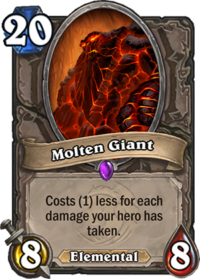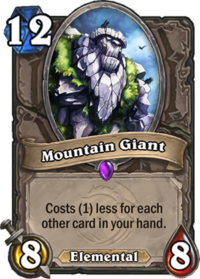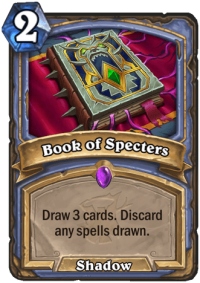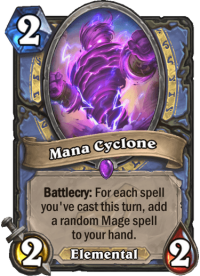Before the nerfs to Conjurer's Calling, many in the community called for a reevaluation of Mountain Giant instead, the other half of the combo which enabled Mages to generate incredible board states and a card which showed up over and over again in Hearthstone’s history as an early big threat which you had to immediately remove. Does it warrant a change – or is its supporting cast a greater cause for concern?
Big Boys on the Block

It just doesn’t feel right when an 8/8 hits the board only a few turns after the game began – but as it turns out, not all Giants are made equal in the game. For starters, the ones in the Classic set greatly differ from the ones added later to the game: their mana condition depended on factors which both players could immediately track and (mostly) affect, not to mention the fact that it often came with some sort of a downside. If your Sea Giant is 0 mana, you are either already winning, already losing, or at least you have a complicated board state to deal with. If your Molten Giant was cheap, it meant that you took a ton of face damage earlier in the match and had to quickly restore parity based on this payoff. If you got away with an early Mountain Giant, it meant that you sacrificed enough tempo to get it off and your opponent hasn’t punished you for it.
So what about the other Giants? With the exception of Clockwork Giant – a weird tech tool from GvG which only saw fringe play in wacky decks – they were synergy cards, lowering the cost of the card over time as you executed your natural gameplan without any sacrifices. Frost Giant for Inspire-based decks, Arcane Giant for spellslingers like Druid and Mage and Snowfury Giant for Overload-based Shaman archetypes worked under very different cost adjustment rules, and there’s a reason why we haven’t seen one of these cards in a long time.

Unlike Sea Giant – which can easily work as a tech tool –, not many decks can successfully pull off the Mountain Giant tempo loss and live to tell the tale. Just cast your mind back to the launch of The Witchwood, a set where Druid received a collection of cards which were intended to increase its hand size (Witchwood Apple) and to secure a payoff off of the effect (Ferocious Howl, Forest Guide, Wispering Woods, Bewitched Guardian). It was a complete failure on an archetypal level, even if some of the cards ended up seeing play in different builds. In fact, for the longest time, the only competitively viable decks featuring the card were all slow Warlocks, with the old Handlock builds going so slow in the early game that even forcing out a Darkbomb was considered a win because it would delay the Mountain Giant. Meanwhile, the Evenlock variants had to suffer the relevant deckbuilding restrictions for a chance to get a giant out in the early game – and though they weren’t often able to duplicate them, the tempo-based nature of the deck meant that a single early Mountain Giant was enough of a swing by itself in most cases if opponent didn’t have an immediate answer for it.
The Call of the Conjurer

Which brings us to Mage and its newfound ability to utilize the card. The first tool to help cheat out an 8/8 early on came in the form of Book of Specters – what do you know, it’s also from The Witchwood! – but it only had limited impact. From a deckbuilding perspective, it created very interesting (and difficult) decisions: do you want to play it safe and fill your deck with minions, thereby reducing your initiative and overall power level, or do you want to make your draws less consistent with the card? All in all, it meant that a turn 3 Giant was fairly rare, and even if it did happen, the Mage player had to pass and ignore the board all the way there. Early builds running Book of Specters card draw mostly relied on Elemental package to “substitute” spells, but we all know how non-optimal it is.
The current Mage decks in the Year of the Dragon had two very specific engines which got the Mountain Giant shenanigans out of hand: the greatly increased payoff with Conjurer's Calling is the one which got all the attention and eventually the nerf bat. However, there’s another, somewhat hidden, but arguably even more important aspect of these decks: their ability to not sacrifice the tempo in exchange for the early Giant.

With Sorcerer's Apprentice and Mana Cyclone, Mages uniquely have the ability to cast multiple cards and therefore actively affect the board state without having to miss out on the early payoff. (Part of this problem is Twinspell, a keyword which allows you to extend cards from your hand without having to lower its overall size. While redraw cards certainly exist elsewhere in the game, they are mostly minions, meaning they don’t have the sort of initiative a Ray of Frost does. The increased consistency provided by the fact that the Giant is now affected by Elemental Evocation further exacerbates this issue (while de facto discount is only 1 mana, it’s often still enough to get him out a turn earlier).
All in all, there’s little to suggest that Mountain Giant itself is the problem, though there’s still a design-related question to discuss here. What is better to nerf, the evergreen payoff or the Standard set’s engine? To highlight the difference between these approaches, consider for a moment how Team 5 decided to butcher all of Druid’s evergreen ramp tools (Wild Growth and Nourish because many prominent strategies were built around indiscriminate ramping with no consideration of card disadvantage or tempo loss. Why could Druids get away with this? Because there was one spell which single-handedly solved all your issues which stemmed from giving up the board and emptying your hand as you ramp to ten mana: Ultimate Infestation. However, the prevailing attitude of Team 5 is to change the evergreen cards which make printing ones like UI problematic in situations like this, even if the issues they were nerfed for weren’t as prevalent in other gameplay environments. The introduction of the Hall of Fame or the butchery of Warsong Commander also underscores this explanation.
Whether this is preferable to the alternative is a question beyond the scope of this article but recognizing what drives the developers’ nerf-related decisions is important if you want to understand which was Hearthstone is headed. Seeing how much Team 5 tends to favor dealing with the evergreen payoff, the fact that they didn’t do so here is indicative of how little a problem they found with Mountain Giant itself – a stance which is borne out by the history of the game.

While I didn’t like CC, especially in Arena, and considering how I originally wanted it to cost 4 Mana as I compared it to Molten Reflection, I somewhat dislike that a whole turn 10 based on a 7 drop + Conjurer’s Calling combo had to be rendered impossible simply because CC displayed the most issues with Mountain Giants.
This left the Mage without many ways of playing the thing or without as much combo potential and along with the needed LPG nerf it instantly brought the mage from good to terrible.
In the long run, for saveguarding an ACTUALLY problematic evergreen card (as the increasing amount of Value and Survivability such as Lifesteal has shown) I wonder if it was worth it.
Team5 really screwed this game for Mage players.
Horrible Quest that takes multiple turns to pull off compared to the other classes.
Nerfed Conjurers Call which was a deck staple, thereby killing Kadgar’s usefulness. Gave a very hard nerf to LPG which is essentially unplayable now, or at best a dead card until late in the game.
Unexpected Results costs too much at 3, by then you’ve already lost tempo, and the minions suck. Improves with Spell damage…like seriously ????
Great Article! Personally, for this card, i originally liked the idea of making it so Conjurer’s Calling considered the mana cost that was actually payed for the card for its effect (if you played a giant for 4 mana, it summons 2 4mana minions instead of 2 12 mana minions). That said, I get that something like that could be confusing and would had requiered a change of the text to clarify.. and even then.. what if you didnt pay any anything for a minion? (like it was summoned by another minion or a spell for example) would you summon two 0 mana minions? Also, it would have forced you to remember how each minion got to the board before playing the card, a mild complexity, but still unnecesary one… in the end, i think they made the right choice. I think they went too far with the galaxy nerf tho, 6 mana would have been better (i think!)
It’s not that complex i think but it requires a different approach. Mana cost can be concidered as a part of a minion’s stats so it could be kept while in play. For example if you handbuff a minion and you play it doesn’t lose of course its additional stats (unless it gets silenced). Why it has to “lose” any cost reduction effect when played? That way though a giant’s cost would change all the time and this doesn’t really make sense, so they would need to change the text also… Of course if you summoned your minion otherwise it would keep its original cost because the reduction works only when played. I don’t really know how easy it is to change this mechanic that way but it’s an interesting idea for the future…